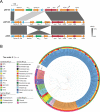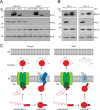The Carbapenemase BKC-1 from Klebsiella pneumoniae Is Adapted for Translocation by Both the Tat and Sec Translocons
- PMID: 34154411
- PMCID: PMC8262980
- DOI: 10.1128/mBio.01302-21
The Carbapenemase BKC-1 from Klebsiella pneumoniae Is Adapted for Translocation by Both the Tat and Sec Translocons
Abstract
The cell envelope of Gram-negative bacteria consists of two membranes surrounding the periplasm and peptidoglycan layer. β-Lactam antibiotics target the periplasmic penicillin-binding proteins that synthesize peptidoglycan, resulting in cell death. The primary means by which bacterial species resist the effects of β-lactam drugs is to populate the periplasmic space with β-lactamases. Resistance to β-lactam drugs is spread by lateral transfer of genes encoding β-lactamases from one species of bacteria to another. However, the resistance phenotype depends in turn on these "alien" protein sequences being recognized and exported across the cytoplasmic membrane by either the Sec or Tat protein translocation machinery of the new bacterial host. Here, we examine BKC-1, a carbapenemase from an unknown bacterial source that has been identified in a single clinical isolate of Klebsiella pneumoniae. BKC-1 was shown to be located in the periplasm, and functional in both K. pneumoniae and Escherichia coli. Sequence analysis revealed the presence of an unusual signal peptide with a twin arginine motif and a duplicated hydrophobic region. Biochemical assays showed this signal peptide directs BKC-1 for translocation by both Sec and Tat translocons. This is one of the few descriptions of a periplasmic protein that is functionally translocated by both export pathways in the same organism, and we suggest it represents a snapshot of evolution for a β-lactamase adapting to functionality in a new host. IMPORTANCE Bacteria can readily acquire plasmids via lateral gene transfer (LGT). These plasmids can carry genes for virulence and antimicrobial resistance (AMR). Of growing concern are LGT events that spread β-lactamases, particularly carbapenemases, and it is important to understand what limits this spread. This study provides insight into the sequence features of BKC-1 that exemplify the limitations on the successful biogenesis of β-lactamases, which is one factor limiting the spread of AMR phenotypes by LGT. With a very simple evolutionary adaptation, BKC-1 could become a more effective carbapenemase, underscoring the need to understand the evolution, adaptability, and functional assessment of newly reported β-lactamases rapidly and thoroughly.
Keywords: Tat pathway; antimicrobial resistance; beta-lactamases; evolution; periplasm; protein secretion; signal peptide; β-lactamase.
Figures



References
Publication types
MeSH terms
Substances
Grants and funding
LinkOut - more resources
Full Text Sources
